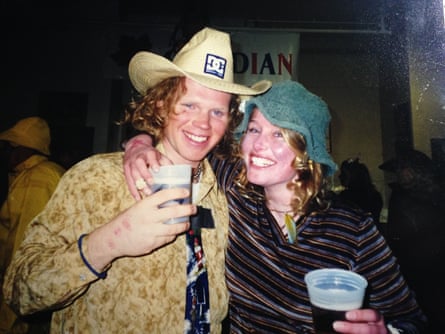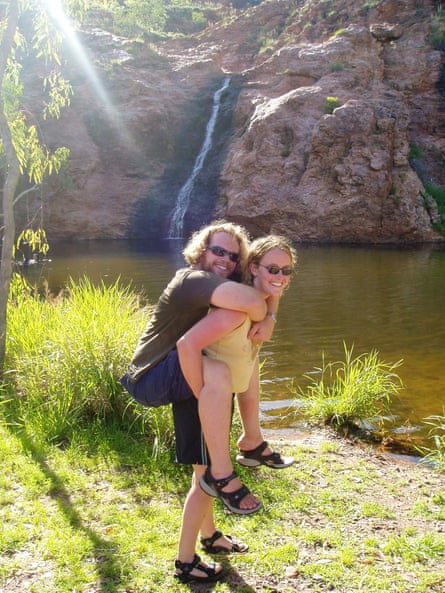“What the hell am I doing? This is completely insane,” I thought, watching as my boyfriend Kev vomited strenuously into a plastic tub. He slumped, shaking and exhausted, back on to a pile of fetid sheets, heated from within by his fever.
We were holed up in a motel room in Warrnambool, on the south-western coast of Victoria, on day two of a four-month camping trip around Australia. Beside the bed sat a shiny new wheelchair he didn’t know how to use.
“He is going to die if you continue,” hissed my mother, voice croaky with concern. She told me it was irresponsible to take a recently disabled man camping in the outback, miles from any hospital. She had planned to accompany us across the Nullarbor and was now, clearly, having serious misgivings.
Maybe she was right – my mind flooded with worries. What if we break down and have to walk for help – or rather, I have to walk for help? A psychopath could kill us and bury us in the desert somewhere. Kev could be savaged by an inland taipan and not feel a thing. He could brush against an Irukandji jellyfish while swimming, or drag his bottom across a stonefish lurking on the sea bed.
Not to mention the myriad medical concerns that accompany someone who is paraplegic. Sand and germs getting into his sterile catheterising process, leading to a kidney infection or blood poisoning. Heat stroke, pressure sores, and autonomic dysreflexia, a potentially deadly, nervous system freak-out – all of which people with spinal injuries are susceptible to, particularly in the murderous heat of an Australian summer. I felt like I was going to hyperventilate.

Five months previously, while running a geophysical survey in northern Canada, Kev had fallen from a cliff, fracturing his leg, puncturing his lung and breaking his back. For hours he lay motionless in the dark forest, unable to feel his lower body and hoping desperately not to attract the attention of the many bears and wolves he’d seen nearby.
In the spinal ward of Vancouver hospital, a nurse directed me to a room in the intensive care section where the soft glow of seemingly infinite monitoring devices provided the only light. Kev lay motionless, crowded out by apparatuses and important-looking machines that pumped, sucked, dripped and kept him alive. Dirt, blood and pine needles matted his long hair, and his face, partially obscured by an oxygen mask, was scratched and coated in mud.
Part of me had hoped I’d find him sitting up in bed reading a magazine, with a leg cast tethered to pulleys and ropes above his head, greeting me with a hearty, “It’s so good to see you, baby.” And it was not like that at all. For the first time I realised that he could die.
Intravenous tubes coiled from needles burrowed into his tanned neck and hands — thick, clever hands, well-formed for holding hammers and wrenches, now so swollen his fingers resembled overcooked sausages on the verge of splitting. He opened hollow bloodshot eyes, and whispered hoarsely through cracked and bleeding lips: “Don’t cry, pretty girl.”
A great heavy pressure settled around my chest and stole my breath. Five days later, the neurosurgeon gently told him he would never walk again.

Kev and I had met a couple of years earlier, both working at a ski resort in British Columbia. That summer, we drove through the Rocky, Kootenay and Selkirk mountains in search of wild country, and through the midnight sun to Alaska in his 1977 Volkswagen Kombi. It was witches-hat orange, had “Fuhkengruven” emblazoned across the rear window and rust crept like lichen over its body. But Kev loved it.
We slept along forestry roads and in campsites without gates so we could sneak out early without paying; we ate salmon and Arctic grayling caught on his fly rod, and hiked often into the high alpine. The rain fell soft on late snow that crunched under our feet, as the eerie sound of shifting glaciers reached our ears. I worried about bears and – after once seeing paw prints in the snow – cougars, but he quietly explained the necessary precautions, carried bear spray on his belt, and loudly sang when we approached berry patches. Marmots whistled and bugs orbited as his warm hand held mine.
But that was then. Six weeks after his accident, by the time Kev was transferred to spinal rehabilitation hospital, his goal had shifted from “walking the hell out of here” to “being the best paraplegic I can be”. He was learning how to sit up without core muscles, how to move in and out of his wheelchair and how to hold a wheelie by lifting the front wheels and balancing on the two large back ones.
Each additional challenge was met with quiet dignity, resolve and a pragmatic positivity. But we both had more to learn than what could be taught in rehab. We knew the kind of lifestyle we wanted to live, and needed to figure out how we could reclaim it.
At a time when even a calamity-free trip out of hospital to a restaurant was an accomplishment, the thought of camping was terrifying. Yet planning a trip meant we could stop looking back at our past lives, and start looking forward to adventure. It could distract us.

So we flew to Melbourne, bought a Hilux, installed dodgy hand controls that enabled Kev to drive (little more than golf clubs duct-taped to the pedals), and stocked up on medical equipment, camping supplies, and large quantities of antibiotics and neuro-suppressors that would be difficult to find outside big cities.
From Melbourne we travelled west, across the Nullarbor, with my anxious, overprotective mother, through the remote north-west with a free-spirited British backpacker, and down the verdant east coast alone. The logistics of travelling at a time when many spinal-injured patients remain in hospital took a toll on us both. He was learning to live in a wheelchair in harsh and challenging country, and I was struggling to accept his paralysis and the changes it had brought upon us. Our relationship was hanging by a thread.
Kev’s health was marginal, with urinary tract infections cropping up like whack-a-mole ferrets, as he churned through the drug stockpile. One particularly nasty infection became systemic in Karinjini, Western Australia, because of the dust in the wind and the ants in the campground outhouse that swarmed across his immobile legs, conspiring to prevent regular catheterisations.
He seared his calf to a weeping, blistered pulp as it rested against sun-baked basalt at a swimming hole outside Katherine, and acquired several inexplicable sores that we hoped were not a creepy tropical parasite. Falls were frequent because of his inexperience shifting or “transferring” from the chair and the spasticity activating muscle groups that sabotaged his transfers by hurling him sideways.
I became adept at unscrewing doors from their hinges to provide a few extra centimetres of clearance. Slabs of wood sufficed as makeshift ramps, and a plastic lawn chair functioned as a shower chair. After countless attempts, the first time Kev independently dragged himself into his wheelchair from the ground was at a remote beachside campground near Exmouth in WA. He held a wheelie through deep sand, mastered a way to climb up and down flights of stairs – pulling his legs up behind him – and dropped down steps and bumped up curbs like a kid on a BMX.

We snorkelled on the Ningaloo in the west and the Great Barrier Reef in the east, rode camels on Broome’s iconic Cable Beach, forded monsoon swollen rivers, marvelled at the abundance of flies and the malicious heat of the desert, ate beer-battered reef fish seasoned with sand and washed down with more beer. Kev learnt to swim and set up a tent from a chair, but most importantly, somewhere in a rainforest north of Cairns, he perfectly articulated his mindset of living peacefully with a disability:
“I’m going to try not to get too upset about stuff I can’t do until I have run through all the things that I can,” he said.
We talked about what we had lost, and held precious what we retained. We learnt to understand Kev’s actual limitations instead of accepting what other people perceived them to be, and realised that as much as it really sucked that the accident had happened, it was not – as we’d initially feared – the end of everything.
